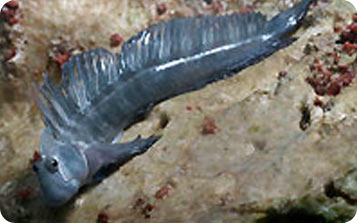If you think a fish out of water would be easy to catch, you haven’t encountered the Pacific leaping blenny.
This acrobatic, slippery little fish can be found hopping and climbing around the rocky coasts of Guam. A diminutive 1½ to 3 inches in length, it spends almost all of its time on land — a curious and unique lifestyle among marine fish. To navigate its rocky habitat, the blenny has developed a tail-twisting move that allows it to leap from rock to rock with impressive distance and agility.
 Pacfic leaping blenny. Credit: Monterey Bay Aquarium/Randy Wilder.
Pacfic leaping blenny. Credit: Monterey Bay Aquarium/Randy Wilder.But these land-loving fish are still bound to the sea for survival. The Pacific leaping blenny has gills, not lungs, and though it can breathe through its skin, it must stay moist at all times to do so. This restricts its hopping grounds to the challenging environment of the intertidal zone. Living here means the blenny has only a narrow window of time for foraging and breeding — between the drying sun of low tide and the crashing waves of high tide.
Learning how this blenny adapts to such challenges may give scientists insight into vertebrate evolution. About 350 million years ago, marine fish thought to be the ancestors of modern land-dwelling vertebrates began making forays into terrestrial habitats. To study this transition, researchers have to rely mainly on fossil evidence. The Pacific leaping blenny, however, is a living, hopping example of how the precursors of land animals may have adapted to the demands of moving from sea to land.


